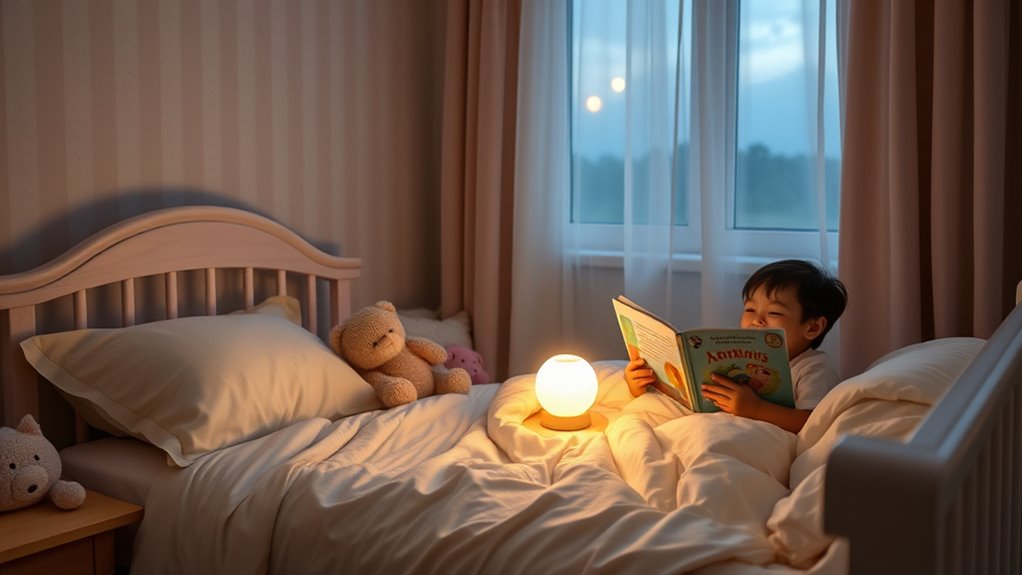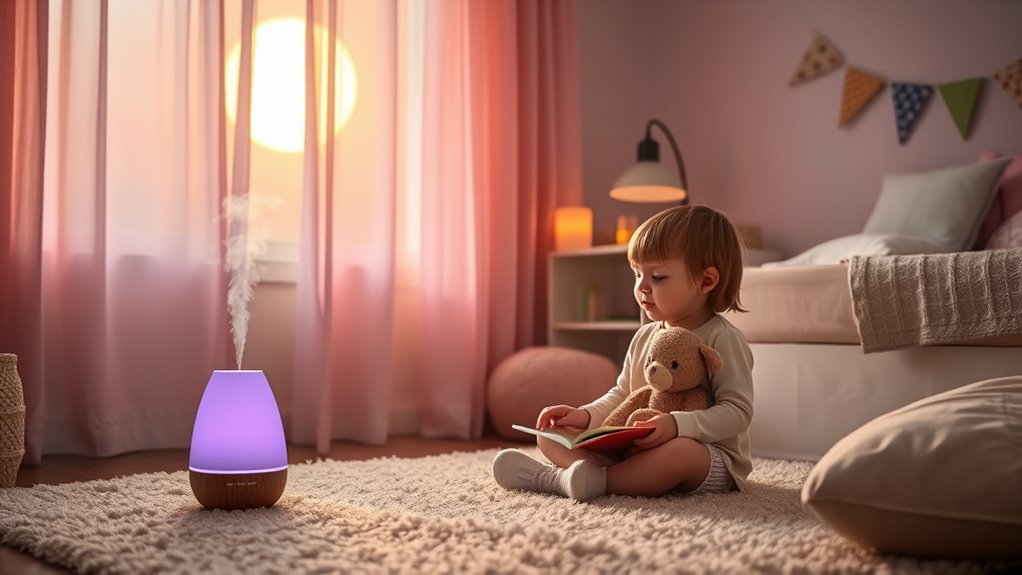To create a sleep-friendly evening routine for your child, establish a consistent schedule that signals bedtime, like dimming the lights and turning off screens at least an hour before bed. Include calming activities such as reading bedtime stories, listening to soft music, or practicing deep breathing. Make sure the environment is cozy—dim lights, comfortable pajamas, and a cool room. If you’d like more tips on making the routine effective, keep exploring ways to foster healthy sleep habits.
Key Takeaways
- Establish a consistent bedtime routine with calming activities to signal it’s time to wind down.
- Incorporate bedtime stories and relaxing music to foster closeness and promote relaxation.
- Limit screen time at least one hour before bed to prevent melatonin suppression and overstimulation.
- Create a sleep-friendly environment with dim lighting, comfortable temperature, and minimal noise.
- Use relaxation techniques like deep breathing or gentle stretching to help children transition peacefully to sleep.

Establishing a consistent and calming evening routine is essential for helping kids wind down and prepare for restful sleep. When your child knows what to expect each night, it creates a sense of security and helps them transition smoothly from daytime activities to bedtime. One effective way to do this is by incorporating bedtime stories into the routine. Reading together not only fosters a close bond but also signals that it’s time to slow down. Choose calming stories that aren’t overly stimulating, and keep the lighting soft to create a cozy atmosphere. As you read, encourage your child to relax and listen, helping them associate storytelling with winding down.
A calming bedtime story routine helps kids feel secure and transition smoothly to sleep.
In addition to bedtime stories, integrating screen free activities is vital. Exposure to screens—whether TV, tablets, or smartphones—before bed can interfere with your child’s ability to fall asleep. The blue light emitted by screens suppresses melatonin production, making it harder for kids to feel sleepy. To promote better rest, set a strict cutoff time for screens at least an hour before bed. Instead, opt for activities that promote relaxation, like drawing, puzzles, or quiet play. These activities help your child’s mind shift from the busyness of the day to a more restful state, making it easier for them to drift off.
Creating a calming environment is also key. Dim the lights and keep the room at a comfortable temperature. You might consider using a nightlight if your child feels anxious in the dark, but avoid bright overhead lighting. Encourage your child to change into comfortable pajamas and brush their teeth as part of the routine. Consistency is crucial; doing the same steps every night reinforces the habit and signals to your child’s brain that it’s time to sleep.
Finally, incorporate some gentle activities that promote relaxation, such as listening to soft music or practicing deep breathing together. These small moments of calm can help reduce any bedtime anxiety and create a peaceful transition to sleep. Additionally, maintaining a consistent routine can help regulate your child’s internal clock and improve sleep quality. Over time, your child will learn to associate these routines with bedtime, making it easier for them to settle down on their own. Remember, a predictable, soothing evening routine that minimizes screen time and includes calming activities will foster healthy sleep habits, ensuring your child wakes up refreshed and ready for the day ahead.
Frequently Asked Questions
When Should My Child Go to Bed for Optimal Sleep?
You should aim for your child to go to bed at a consistent time each night, typically between 7-9 pm, depending on their age. Make sure their sleep environment is cool, dark, and quiet, and avoid sugary bedtime snacks that can interfere with sleep. Establishing a regular bedtime helps your kid’s body clock adjust, ensuring they get enough restorative sleep and wake up refreshed and ready for the day.
How Can I Handle Resistance to Bedtime Routines?
When your child resists bedtime routines, stay calm and use praise strategies to encourage cooperation. Consistency techniques, like sticking to the same routine every night, help your child feel secure and reduce resistance over time. Offer gentle reminders and positive reinforcement, emphasizing what they enjoy about bedtime. By maintaining patience and consistency, you’ll help your child develop healthy sleep habits and make bedtime a smoother, more pleasant experience.
What Should I Do if My Child Wakes up During the Night?
When your child wakes up during the night, stay calm and keep interactions brief to avoid disrupting their shift back to dream sleep. Gently reassure them without turning on bright lights or engaging in lengthy conversations. Use a consistent, soothing approach to help minimize night waking, encouraging your child to return to sleep independently. Over time, this consistency promotes better sleep habits and reduces frequent night waking.
Are Screen-Free Evenings Necessary for Good Sleep?
Imagine your child’s brain as a computer overheating from endless screen time—no digital detox in sight. Screen-free evenings aren’t just a trend; they’re essential. Cutting the screens helps your kid’s brain wind down, reducing stimulation and promoting better sleep. Without the digital overload, your little one can relax, breathe easier, and drift off peacefully. So yes, those screen-free evenings are a must for truly restful nights.
How Long Should the Bedtime Routine Last?
The ideal bedtime duration varies, but aim for a routine lasting about 20 to 30 minutes. This helps your child wind down without feeling rushed. Consistency is key, so try to keep the routine the same every night. A predictable schedule signals bedtime, making it easier for your child to shift to sleep. Keep activities calming and brief to make sure they’re relaxed and ready for a restful night.
Conclusion
By establishing a calming evening routine, you’re setting your child up for the best sleep of their life—better than a night in a palace of clouds! Consistency and gentle activities work like magic, transforming bedtime from chaos to calm. Remember, your efforts craft the foundation for their health, happiness, and bright future. Keep at it, and soon you’ll see your little one drifting off peacefully, proving that a peaceful night’s sleep is truly the greatest gift you can give.









